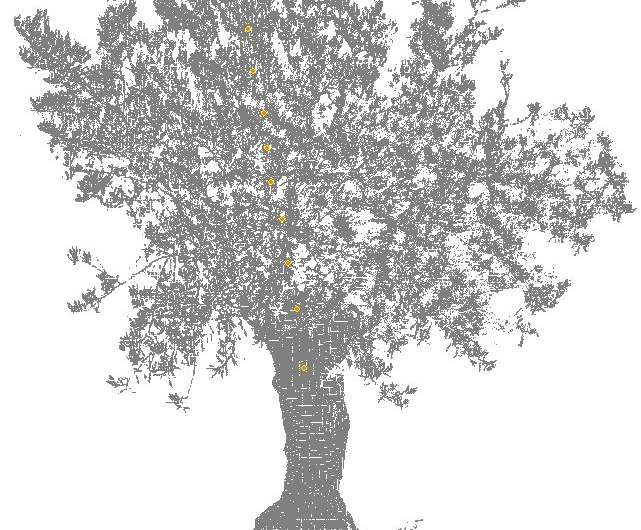Researchers report overnight cycle of water movement in trees

A high-precision, three-dimensional survey of 21 different species of trees has revealed an as-yet unknown cycle of subtle canopy movement during the night. Such 'sleep cycles' differed from one species to another. Detection of anomalies in overnight movement could become a future diagnostic tool to reveal stress or disease in crops.
One of the most important processes sustaining life on Earth is the transport of water from the ground and into the leaves, where photosynthesis occurs. The process has fascinated scientists for centuries, and is still debated in plant physiology. Scientists generally agree that water transport is driven by light, and consequently occurs in 24-hour cycles.
Overnight movement of leaves is well known among tree species of the legume family, but it was only recently discovered that some other trees also lower their branches by up to 10 centimeters at night and then back in the morning. These branch movements are slow and subtle, and are difficult to identify with the naked eye at night. However, terrestrial laser scanning, a 3-D surveying technique developed for precision mapping of buildings, makes it possible to measure the exact position of branches and leaves. This technique was recently used to demonstrate movements in the branches of birch trees under field conditions.
When a team of researchers from Denmark and Hungary repeated the experiment by bringing 22 individual tree and shrub species together and scanning them overnight under strictly controlled conditions, they were surprised: "We detected a previously unknown periodic movement of up to one centimeter in cycles of two to six hours. The movement has to be connected to variations in water pressure within the plants, and this effectively means that the tree is pumping. Water transport is not just a steady-state flow, as we previously assumed," said postdoc András Zlinszky at Aarhus University, department of Ecoinformatics & Biodiversity.
Pulses of movement
All the trees showed some kind of branch or leaf movement of a few centimeters during the experiment. However, the overnight 12-hour cycle of lowering and returning to the starting position was only observed in seven of the species studied. The results revealed that some trees have "sleep periods" shorter or longer than 12 hours, and others show slow continuous movement in one direction, probably because of disease or senescence.
The most striking finding was that all the studied plants displayed pulses of minute periodic movement overnight. This was particularly striking in the magnolia tree, which completed three full cycles of up-and-down branch or leaf movement over one night. Although the crown displacement measured was only about 1 centimeter, the scientists are confident that this is not a measurement error.
Short-term plant movements are caused by changes in water pressure within tissues. It is generally assumed that water transport in trees takes place as a steady-state process with no variations faster than the day and night cycle. The new findings suggest that short-term change in water transport and tissue pressure is widespread.
Interesting perspectives
Observations of barely detectable fluctuation in trunk diameter have earlier been dismissed as noise. However, such noise could well be the result of a hitherto unknown water transport mechanism in plants causing short-term changes in trunk volume and water pressure. The exact role and mechanism of this process have to be studied with further dedicated experiments, but these findings definitely challenge the widespread view of trees as static, passive organisms.
The wider perspective of the results are interesting: "We believe that detection of anomalies of overnight movement could become an efficient diagnostic tool to reveal stress or disease in crops. This would open up for early intervention, which is not only cost efficient but also more environmentally friendly," said Anders S. Barfod, Associate Professor at Aarhus University, Department of Ecoinformatics & Biodiversity.
More information: András Zlinszky et al, Short interval overnight laser scanning suggest sub-circadian periodicity of tree turgor, Plant Signaling & Behavior (2018). DOI: 10.1080/15592324.2018.1439655
Provided by Aarhus University





















